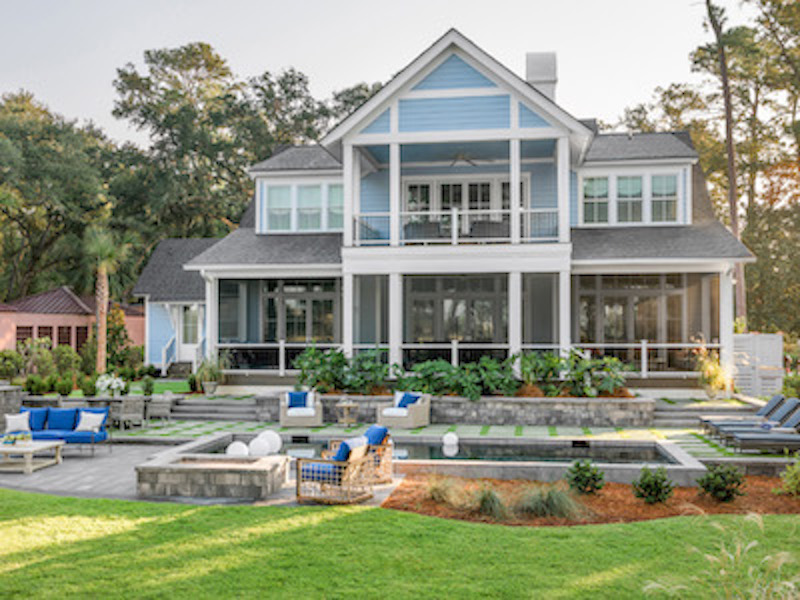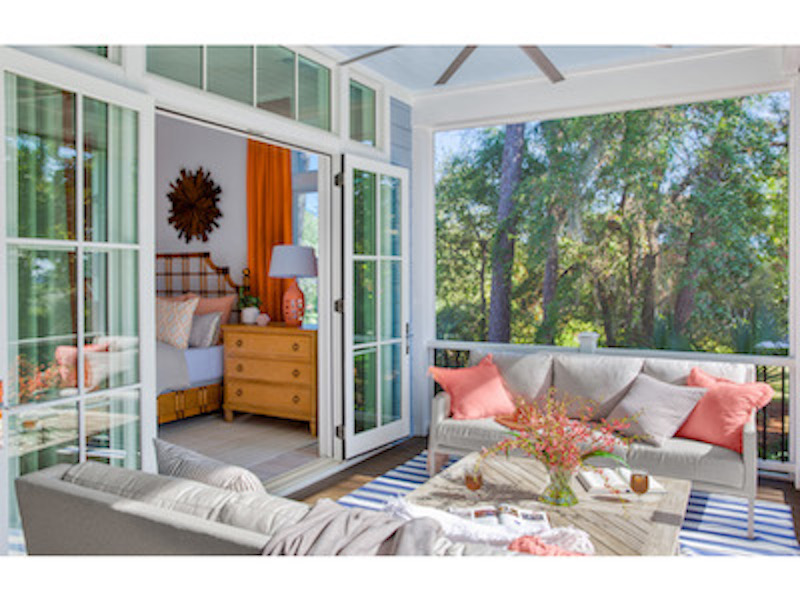
The contemporary design of the outdoor space brings an unexpected edge to this more traditional home. The black pebble pool liner adds drama and also creates a mirror effect on the water. Surrounding the pool are gorgeous paver stones in a grid pattern and accented with artificial turf. An outdoor kitchen with seating for four and a paver stone fire pit completes the look.
It’s Lowcountry, but it’s also not
A lot of baggage comes with the term “Lowcountry” in terms of home design—elements like tin rooflines, tabby accent walls and natural textures. And while you’ll see some of the calling cards of Lowcountry design in the home, such as the emphasis on outdoorspaces, there is plenty about this property that strays from the formula.
“It’s probably better to think of it as where Lowcountry is headed, as far as a transitional piece, architect William Court said. “Obviously, it still responds to the Lowcountry environment—the views, the outdoor living, all of the pieces and parts that you would associate with a Lowcountry home. But it’s more open; it’s more flowing … everything is sort of up to date. It’s certainly pulling on new trends.”
That subdued take on coastal Lowcountry made its way into the design of the house as well.
“The house offers people a fresh take on coastal,” Flynn said. “You’ll see some literal nods like the boats on the wall, but we’ve put them in places that aren’t conspicuous. I didn’t want it to be front and center. All those things that are straight up literal are kind of tucked away.

This space features a floating floor plan which allows for really great flow through the room. The focal point is a floor-to-ceiling tabby fireplace accented with custom fish scale art.
TV played a huge role in design
One of the many differences between the HGTV Dream Home and your home is that your home probably isn’t going to be on TV any time soon. While it seems obvious that the HGTV Dream Home was built for television, the extent of its role as an active shooting set played a huge part in how it physically came together.
“A lot of the decisions HGTV made were regarding how the TV component would show. There was a lot of stuff we typically worry about that really didn’t matter because they weren’t going to shoot that room,” Court said.
“In our homes, we know people are going to walk room to room. On a show, people are only going to see what’s in that shot, so if there was a closet we would normally focus on for example, we would put that focus more on things like the outdoor spaces…. There is a lot of rethinking what happens when you’re given a kit of parts and then making the most of it.”

The multipurpose room on the second level of the home is perfect for hanging out, playing games, or watching movies and is a cozy spot to curl up with a book.
Creating a floorplan and a design for television was a challenge Court Atkins rose to beautifully, but for Flynn it was yet another chance to create for the cameras.
“It’s a really fine line between pushing the envelope and just having mass appeal. In a perfect world, if I was doing your house, there would probably be a lot more patterns on the walls; I would probably do a black room; I would probably have a lot more mirrors,” he said. “There are not that many mirrors in the house because it’s also a TV set while we’re making it. You’ll notice mirrors tucked in the corners because you don’t want that reflection while you’re filming it.”

The master suite is resplendent with a muted coral color scheme, a West Indies cane-style king bed and a private patio with a marsh front view.
Sponsors also played a role
In addition to designing for the cameras, Court Atkins Group found that spotlighting the show’s sponsors was a necessity of the layout. “We knew how we wanted to lay it out, but we knew we were getting this appliance, this cabinet, so it was a matter of picking the best options based on that. That changed things in the architecture,” Court said. “It would be like any client who comes in already knowing what they want. It streamlines it.”

The master suite is resplendent with a muted coral color scheme, a West Indies cane-style king bed and a private patio with a marsh front view.
Like Court, the balancing act for Flynn also involves showcasing product sponsors. “The creative license is not necessarily there because I’m also working with our partners: the paint companies, the furniture companies, the flooring companies—and there are specific things they want to see in the house as well. It’s kind of like playing with a puzzle all the way until the very last flower is put in the very last vase.”

The private patio off of the master suite is a great place to sip coffee and read the morning newspaper.
Flynn played it safe (sorta)
While his own home in Atlanta is a masterclass in midcentury modern monochrome, designing for HGTV’s Dream Home means Flynn has to adapt to the environment of wherever he’s designing. And while you might think that means taking some risks, the nature of the project demands a sense of caution.

The second guest bedroom is tropical in theme with a palm frond upholstered bed, a woven raffia nightstand and sisal area rug.
“At the end of the day, the most important thing for an HGTV Dream Home to be successful is we want a lot of people to sign up to win, and we want one lucky winner to actually win the house,” he said. “So, if I experiment too much, like if each room is really out there, it would really narrow the audience.”
That said, he was able to get a little playful with things like color, particularly the jewel-toned blue of the exterior.
“The exterior was originally supposed to be neutral, but it wasn’t reading for me. It was just reading beige. So, I said we’re in a coastal town, we have to change that to blue,” he said. “I figured when we were picking colors, being right on the water, that was the most coastal color. The thing I liked about it is it stands out.”
And while he couldn’t experiment too much, the range of greens and aquas found throughout the house show that Flynn was still empowered to have a little fun with his design.

The laundry/mudroom features a dog wash station, a stylish dog kennel which doubles as a place to fold laundry, and washer and dryer.
“In a perfect world, I’d love to use all white and blue everywhere. But when you’re making your way through the house and you go from blue and white room to blue and white room you’d think, ‘I didn’t really learn anything from this house.’ It would have been safe, but that’s not my job. My job is to put something out there that’s going to be fresh. At the end of the day it’s not a set; it’s a real house someone’s going to live in.”
DIY Behind the Build: HGTV Dream Home 2020 airs on DIY Network at 11 p.m. Dec. 30, while HGTV Dream Home Special 2020 airs on HGTV at 8 p.m. Jan. 1.





